Honor award
Newfoundlandscape: Landscape as Rural
Outport Regenerator
Matthew A. J. Brown, Student ASLA, University of Toronto
Faculty Advisor: Alissa North
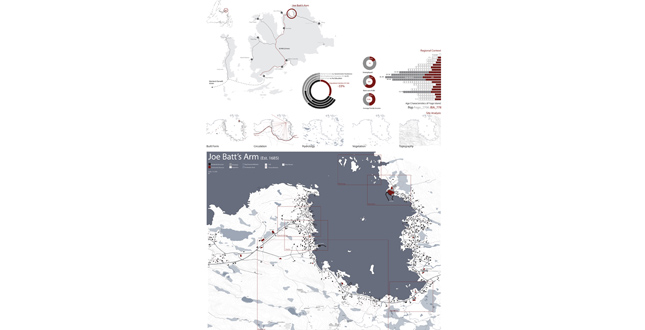 Close Me!
Close Me!Specific Site Plan: To best understand specific site design potentials for each coastal opportunity, Joe Batt’s Arm is used as a case study. Joe Batt’s Arm is a typical outport community in its demographics, coastal landscape and coastal urbanism. Its strategic location on Fogo Island provides the opportunity for all six of the coastal opportunities.
Download Hi-Res ImagePhoto: Matthew Austin John Brown
Photo 1 of 16
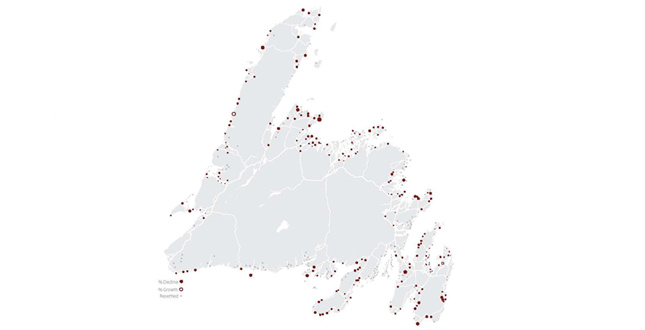 Close Me!
Close Me!Outmigration: The province of Newfoundland has consistently been challenged by population loss. The following diagram shows population decline around the Island.
Download Hi-Res ImagePhoto: Matthew Austin John Brown
Photo 2 of 16
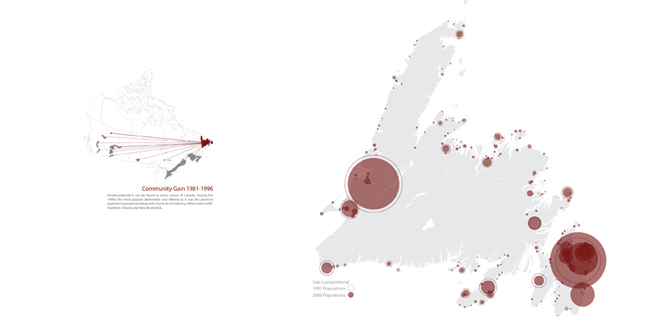 Close Me!
Close Me!Population Concentration: Newfoundland’s population is scattered around its rugged coastline, but due to outmigration the majority of Newfoundlanders (180,000 of 510,000/35%) now reside on the Avalon Peninsula. St. John’s and its surrounding CMA area continue to grow with an increase in industry and economy.
Download Hi-Res ImagePhoto: Matthew Austin John Brown
Photo 3 of 16
 Close Me!
Close Me!Correlating Decline: It can be seen that the population of Newfoundland directly correlates to the boom and bust of the economy, which in this case is dependent on non-renewable industry. The oil industry is lucrative and although providing financial stability for the province at the moment, it does not provide adequate employment and will eventually cause another wave of outmigration.
Download Hi-Res ImagePhoto: Matthew Austin John Brown
Photo 4 of 16
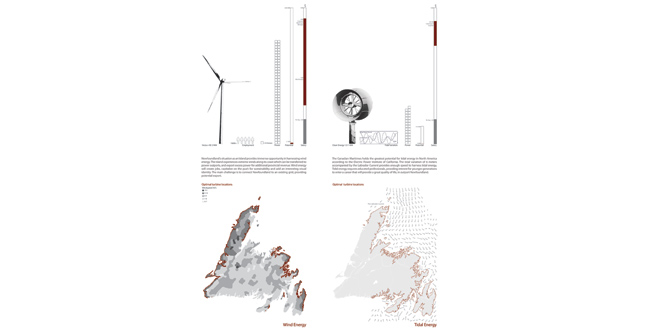 Close Me!
Close Me!Six Coastal Opportunities: Change is inevitable, and it is now time to re-envision these communities to capitalize on their unique coastal positioning and existing infrastructures. These combined opportunities can create new forms of renewable industry that will help maintain outport populations and provide opportunities into the future.
Download Hi-Res ImagePhoto: Matthew Austin John Brown
Photo 5 of 16
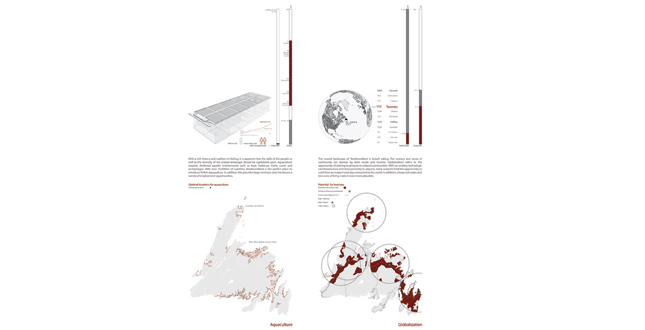
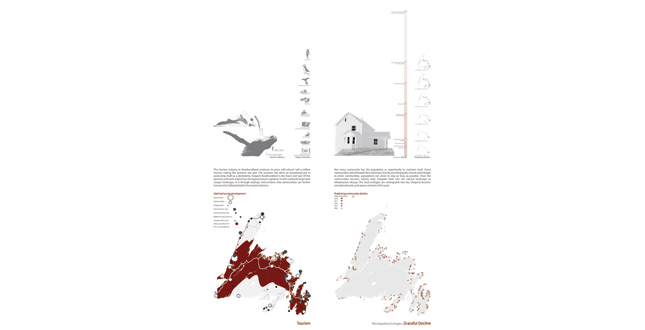 Close Me!
Close Me!Tourism and Reintegrating Ecologies_Graceful Decline
Download Hi-Res ImagePhoto: Matthew Austin John Brown
Photo 7 of 16
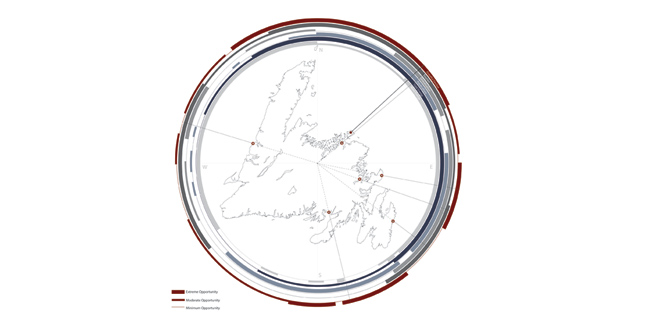 Close Me!
Close Me!Empowering Outports: This diagrammatic wheel combines the analysis of the six coastal opportunities to allow for each outport to locate itself and the most feasible opportunity for future industry. By drawing a line that extrudes from the centre point of the diagram and passes through their specific outport, it will cross six different opportunities, each having a scale of potential (extreme, moderate or minimum).
Download Hi-Res ImagePhoto: Matthew Austin John Brown
Photo 8 of 16
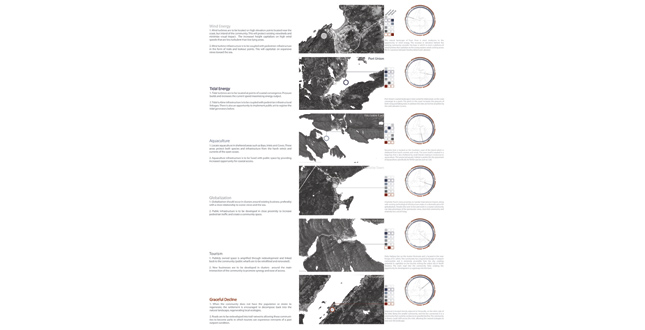 Close Me!
Close Me!Development Application: 2 rules for each opportunity will guide the community to strategically place industry in order to maximize efficiency according to site. 6 Samples applications are provided.
Download Hi-Res ImagePhoto: Matthew Austin John Brown
Photo 9 of 16
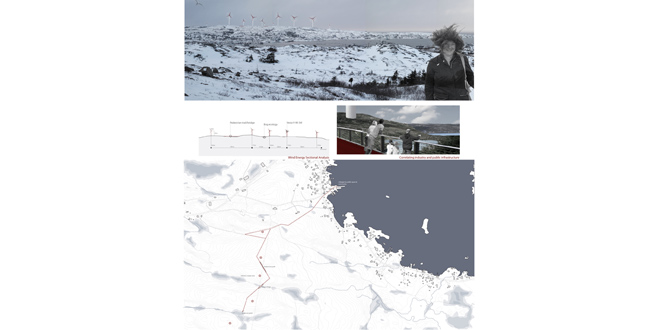 Close Me!
Close Me!Wind Energy Strategy: Joe Batt’s Arm provides wind speeds at velocities above 9 m/s. This proposal calls from five wind turbines that would produce enough power for about 3800 homes. 310 which are located in the community. The additional power could be exported for additional revenue. Five wind turbines create 25 new jobs for.
Download Hi-Res ImagePhoto: Matthew Austin John Brown
Photo 10 of 16
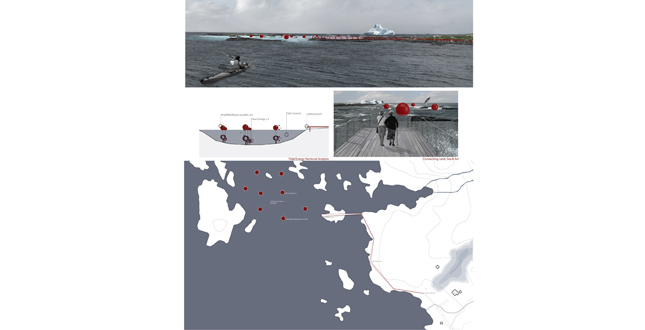 Close Me!
Close Me!Tidal Energy Strategy: Being situated on the most northern edge of the province is beneficial in regards to tidal energy. The coastal convergence provided by a series of rocks is conducive to a tidal energy field. Implementing eight Clean Energy 1.0 generators will produce enough energy to power 2160 homes, providing excess power to export to the existing grid for revenue and community gain.
Download Hi-Res ImagePhoto: Matthew Austin John Brown
Photo 11 of 16
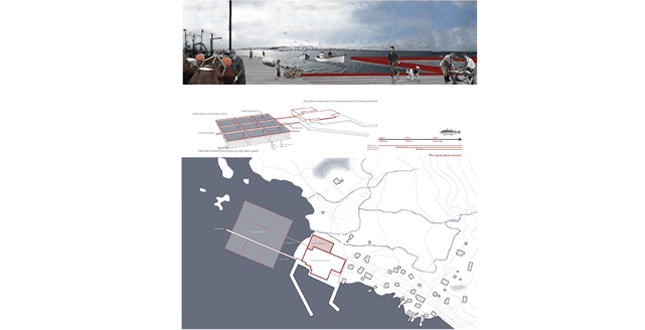 Close Me!
Close Me!Aquaculture Strategy: Introducing aquaculture can capitalize on the skills of the local population sand provide a diverse range of new jobs. The existing fish plant is conducive to harvesting aquaculture. Aquaculture provides opportunity for young people of outports to leave and gain an education in this new science in order to return and start a career.
Download Hi-Res ImagePhoto: Matthew Austin John Brown
Photo 12 of 16
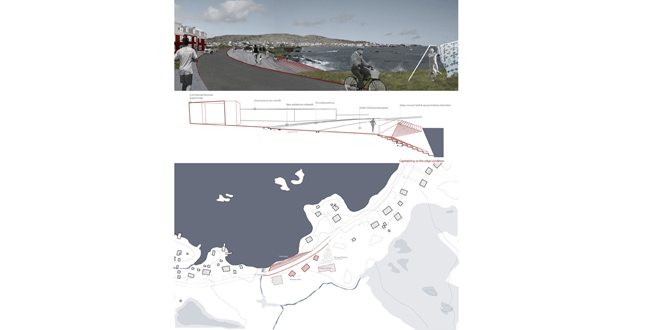 Close Me!
Close Me!Globalization Strategy: Joe Batt’s Arm is approximately 1.5 hours from Gander, providing access to an international airport. This connectivity in addition to the existing technological infrastructure makes it a great place to start a global business/firm. The low cost of living and relatively inexpensive real estate make it a profitable venture.
Download Hi-Res ImagePhoto: Matthew Austin John Brown
Photo 13 of 16
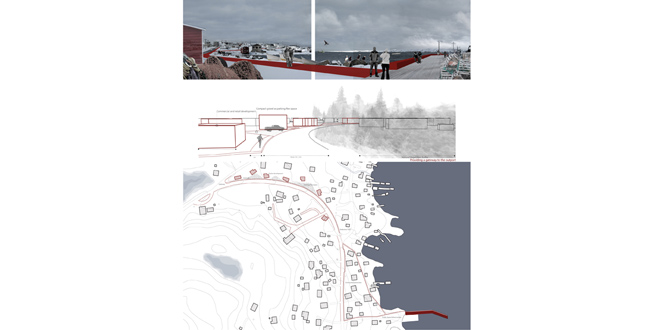 Close Me!
Close Me!Tourism Strategy: The goal of the tourism strategy is to cluster development and retail in order to create a gateway into the community, promote a pedestrian friendly environment, and generate revenue. Retrofitting the government wharf provides a unique public space which links to the community.
Download Hi-Res ImagePhoto: Matthew Austin John Brown
Photo 14 of 16
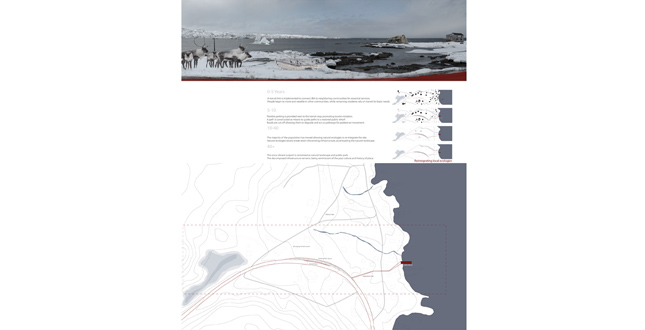 Close Me!
Close Me!Graceful Decline Strategy: The Graceful Decline Strategy is simple. Let it go. Transit is implemented to allow those who wish to stay a means to acquire life’s essential necessities. The existing roads then become trails, and the once private space become public.
Download Hi-Res ImagePhoto: Matthew Austin John Brown
Photo 15 of 16
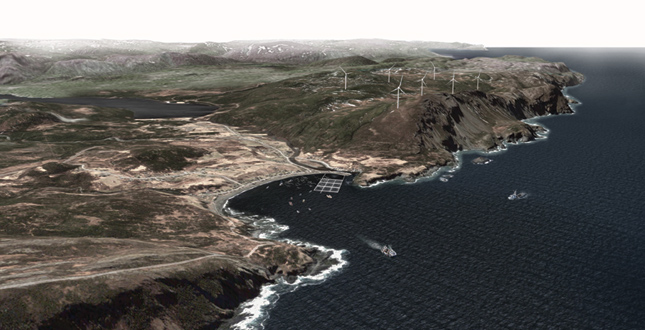
Project Statement
This project uses landscape to re-envision the future of rural Newfoundland by capitalizing on its unique geographic location and existing infrastructure. Newfoundland is a province that has been plagued by outmigration and population loss due to the collapse of the traditional fishery. New renewable industries, driven by landscape, can be implemented to maximize productivity for both the people and the local ecology, regenerating these rural outport settlements: saving a people and their place.
Project Narrative
Introduction
With the introduction of Landscape Urbanism there has been a major shift in the importance placed on landscape to inspire and create change in the environments in which we live. Over the last few decades, landscape is seen as a catalyst for positive change in urban environments, but can this paradigm change be applied to the rural outport settlements in Newfoundland?
Newfoundland enjoyed years of economic prosperity from its varied coastal landscapes, but the collapse of the fishing industry caused the Province a continuing period of economic instability and a migration off the island. With the demise of the cod fishery in the early 1990’s, people migrated from the outports to urban centres such as St. John’s, in search of employment. With a passionate attachment to their coast, rural Newfoundlanders continue to struggle to hold on to their communities, their history and their culture. To move forward, the people need to understand that change is needed to save their communities. It is only then that the outports can be re-envisioned in order to capitalize on their unique geographic locations and existing infrastructure. It is vital that new forms of industry are adapted to outports to maximize productivity for the people and the local ecology. This project provides strategies to mitigate the migration off the Island.
Analysis
The initial analysis identifies the need for a new outlook on coastal industry. Between 1950 and 1960 the government of Newfoundland promoted resettlement programs that relocating over 40,000 Newfoundlanders and destroyed over 250 outport communities. Further, the demise of the fishing industry caused another wave of population loss and outmigration that still exists today. Out of the 227 coastal outports left on Newfoundland, 213 are experiencing outmigration at an average loss of 25.5% over a 15 year period. The problem of outmigration is easily understood through the analysis of statistics but the more appropriate analysis is the potential for change.
Newfoundland built its foundation on the fishing industry, and although this industry will always play an important role in outport life, it will never again be to the same extent as the past. It is important to understand that change is inevitable and there is no better time to re-envision these communities. Six potential renewable opportunities were researched as they provide the unique ability to sustain small outports. The 6 renewable industries are Wind Energy, Tidal Energy, Aquaculture, Globalization, Tourism, and Graceful Decline (re-integrating ecologies). Each of these 6 opportunities builds a new industry that will create jobs and revenue, sustain the current population, and providing the younger generation with the opportunity to come home.
Newfoundland’s Renewable Industry Potential
Wind Energy: Newfoundland’s situation as an Island provides immense opportunity in harnessing wind energy. The Island experiences extreme winds along its coast which can be transferred to power outports, and export excess power for additional revenue.
Tidal Energy: The Canadian Maritimes holds the greatest potential for tidal energy in North America according to the Electric Power Institute of California. The tidal variation of 0.6 meters accompanied by the Labrador Current provides enough speed to harness tidal energy.
Aquaculture: With a rich history and tradition in fishing, it is apparent that the skills of the people as well as the diversity of the coastal landscape are conducive to aquaculture. The sheltered aquatic environments such as bays, harbors, inlets and coves scattered around the 20,000km of coastline make it a perfect place for this growing renewable industry.
Globalization: The scenery and sense of community in outport Newfoundland is desired by both locals and tourists. Globalization refers to the opportunity of starting businesses in these rural places. With an existing technological infrastructure, close proximity to airports and a low cost of living, outports have the potential to play a part in today’s global economy.
Tourism: Tourism in Newfoundland continues to grow with almost half a million tourists visiting last year. This strategy identifies strategic interventions in outports that will enhance their ability to compete in the international tourism market.
Graceful Decline: Not every community has the population or opportunity to maintain itself. Some communities will face extinction, but by providing public transit and linkages to other communities people can remain as long as they wish. When there ceases to be population, the communities are then are given back to the natural landscape and become recreation parks remnant of the past.
Overall Provincial Strategy
Extensive mapping of the six coastal opportunities were distilled into a diagrammatic opportunity wheel to help empower outport communities. Communities can use this wheel to locate themselves, and indentify the opportunities that are most relevant for their coastal position. In addition, two rules for each opportunity are provided, helping them identify site specific development. By doing this, the fate of the outport is handed back to its people allowing them to understand their potentials and move forward in a direction that they choose and are comfortable with.
Site Design Strategy
To best understand specific site design potentials for each coastal opportunity, Joe Batt’s Arm is used as a case study. Joe Batt’s Arm is a typical outport community in its demographics, coastal landscape and coastal urbanism. Its strategic location on Fogo Island also provides the opportunity for all six coastal renewable industries. Each opportunity is designed to maximize the efficiency of the renewable industry, but also providing a public space component that will benefit both the local community and tourist.
Impact
This project uses landscape to spark a much needed conversation in the province of Newfoundland and Labrador. Both the Government of Newfoundland and the people of Newfoundland need to understand that there are a plethora of opportunities for rural outport settlements. The landscape and unique coastal positioning of these communities provides exceptional promise for renewable industry that can start to re-generate and sustain outports. Newfoundland needs to stop placing all of its emphasis on the non-renewable industry of oil and look at renewable opportunities that will provide its people with the option of staying and working in their communities while contributing to the economic stability of the Province as a whole.
On a larger scale this project introduces the potential of landscape architecture to position itself in the rural context, providing renewable industries driven by landscape that could change the current dismal fate of rural North America.
Additional Project Credits
A thank you to everyone in Newfoundland who took the time to help me further comprehend the complex issues facing rural Newfoundland. Wayne Hodder, Ray Johnson, George Whey, Zita Cobb, Pete Decker, Freeman Compton, Ivan Jacobs and Verna Jacobs and the graduating class of Fogo Island Central Academy. Also, thank you to Anthony Cobb for his support throughout the project and at the final review.
A very special thanks to the MLA Class of 2010 as it is the conversations and debates throughout the year that helped push the project to its full potential.





